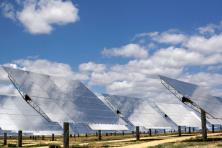Tobacco in service of the climate
The Boeing Company, South African Airways, and Dutch aviation biofuels SkyNRG announced a partnership to develop biojet fuel from a new type of nicotine-free tobacco plant called Solaris to be grown in rural South Africa, a move designed to both reduce the airline’s carbon footprint and provide economic development for farmers. In an unrelated development, a group of South Korean scientists have used pyrolysis to transform cigarette butts into a carbon-based material to attach to electrodes in supercapacitors that has proven capable of storing more energy in superconductors than conventional carbon. The material can be made into batteries that store renewable energy.
Beijing banning coal and boosting solar
Beijing’s Municipal Environmental Protection Bureau announced that the Chinese capital and surrounding districts will stop using coal and other polluting fossil fuels by 2020. Coal comprised 25 percent of the energy in 2012 for the city’s 21 million residents. China is upping its solar capacity to substitute for polluting fuels. In the six months from Jan. to June 2014, China added capacity from solar equal to Australia’s entire solar supply. If China stays on course with plans, the country will install an average of one gigawatt a month through 2014, bringing the total installed to 36 gigawatts, three times the United States’ installed solar capacity of 12 gigawatts.
Don’t step on that ant
A new study out of the University of Arizona Tempe reveals that certain ant species create calcium carbonate (limestone), a process that traps carbon dioxide in rocks, breaking down minerals 50 to 300 times faster than sand. Researchers do not know precisely how the ants perform this natural form of carbon sequestration, nor how much atmospheric carbon the ants may have stored over time, but the study’s author, Ronald Dorn, believes that the amount could be significant from the time that ants began expanding in number 65 million years ago.
How much do electric vehicles cost?
A study of 25 utilities in 14 states that offer rates specifically for electric vehicle charging found that the average equivalent “price per gallon” for electric vehicles is 75 cents, as compared to an average cost of gasoline in the same states of $3.70 per gallon. University of California at Davis released a tool called the EV Evaluator that makes it easy to determine how much money a car owner can save by switching from a gasoline vehicle to an electric vehicle.
Setting the record straight
Cofounder and chief scientist for the Rocky Mountain Institute Amory P. Lovins jumped quickly to quash an erroneous report first issued by the Brookings Institute fellow Charles R. Frank, Jr. that offered the conclusion that solar and wind power cost the most to reduce GHG emissions, while nuclear plants costs the least. The report later found its way into The Economist. Writing separate pieces in Forbes and GreenTech Media, Lovins explains how Frank relied on outdated or incorrect data to reach his conclusions.
Bending the emissions curve downward
The World Resources Institute has created a graphic that depicts four different emissions scenarios ranging from a low-carbon future to a high fossil-fuel future and demonstrating that it is still possible to prevent the most cataclysmic impacts of climate change, if considerable effort is exerted. In advance of the 2015 climate talks in Paris, the United Nations issued a report saying a 40 to 70 percent decrease in emissions by 2050 is what the climate needs. But MIT released a paper concluding that while an agreement (hopefully) reached in Paris may put the world on a path to reduce emissions, it will likely not be enough to achieve climate goals.
Four reasons for surge in EE financing
Not long ago, funding for energy efficiency projects was becoming nearly impossible to get, but EE financing appears to be picking up globally: $104b in bonds from Deutsche Bank and $6.69b in France for residential projects; $30m in Connecticut for commercial efficiency; and $220 million from NY Green Bank. Why? Companies are worried about energy costs; there have been vast improvements in efficiency technology; energy efficiency business models have matured; and commercial and residential contractors are shifting to focus on efficiency.
Climate help from carbon-storing soil
Research from a New Mexico State University scientist examining the best way to capture carbon dioxide in soil while improving agriculture found sustainable agriculture practices that do not disrupt diverse microbial communities in soil are best for plants and for storing carbon. Colorado State University faculty have developed the first-ever online tool thatprovides uniform measurements for measuring changes in greenhouse gas emissions and carbon storage from different land management practices. The report and tool will help ranchers, foresters, and farmers evaluate how well their land practices mitigate carbon pollution and possibly help them participate in emerging carbon markets.




